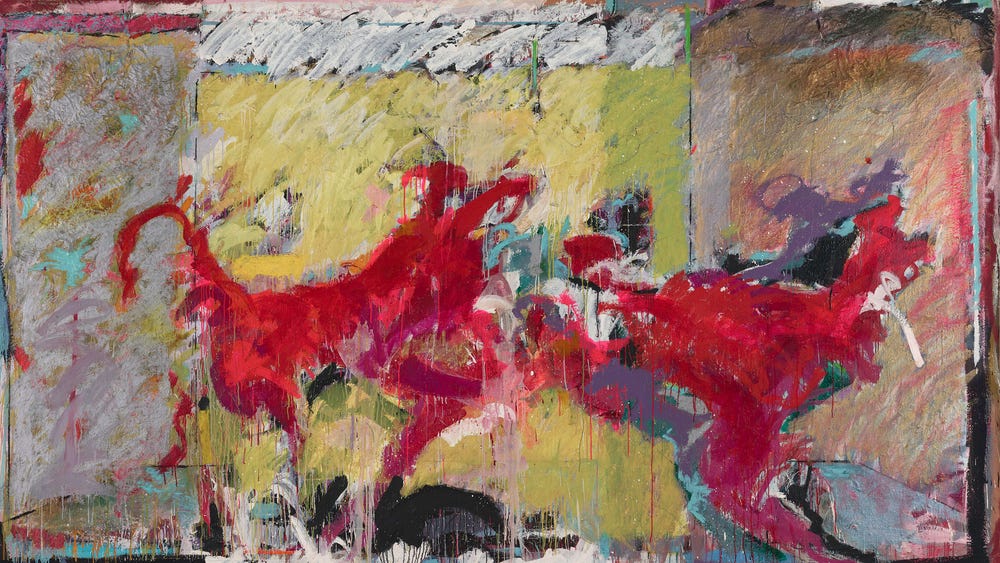Mary Lovelace O’Neal, Driskell’s Red Dogs, aka I Live in a Black Marble Palace with Black Panthers and White Doves #8 (detail), ca. 1990. Mixed media on canvas, 81 x 138 in. (205.74 x 350.521 cm). Museum purchase, Phyllis C. Wattis Fund for Major Accessions, 2022.35. © Mary Lovelace O'Neal. Photograph by Randy Dodson
Oil and metallic paint, torn paper, pastel, dried pigment, and glitter — our new painting by Bay Area artist Mary Lovelace O’Neal, Driskell’s Red Dogs, aka I Live in a Black Marble Palace with Black Panthers and White Doves, ca. 1990, is a vibrant explosion of color. While it came to us in good condition, all artworks are assessed by our conservation division before going on display. Tricia O’Regan, paintings conservator, noticed that the painting was hanging slack and concluded that its stretcher needed to be replaced. “Conservation is all about problem solving,” she said. “It’s rarely the same problem twice.” Conserving this artwork, with its multilayered, 3D surface, was a puzzle that required a creative solution.
Driskell’s Red Dogs, aka I Live in a Black Marble Palace with Black Panthers and White Doves in the conservation lab, before undergoing treatment
The back of the painting with original wood stretcher, resting on an easel
Looking at the painting, you can see that it’s not smooth. A combination of materials contributes to its varied texture. It’s also a large painting, measuring almost 7 feet tall by 12 feet wide. “Handmade stretchers that aren’t strong enough for a canvas’s very heavy paint layer come up a lot with Bay Area artists,” said O’Regan. “While we normally focus on what’s on the front of a canvas, it’s the support systems on the back that ensure a piece is stable enough to be displayed.” The conservation team’s challenge was to come up with a safe way to place the painting facedown. This would allow them to remove and replace the wood stretcher bars while protecting the artwork’s fragile, collaged surface.
Detail showing the 3D surface
Detail showing the 3D surface
The solution: create a map of the artwork noting the areas of protruding materials. O’Regan and Adal Castrillon, senior museum technician, laid a piece of clear film over the front of the painting and traced around the protrusions. Then, creatively reusing three pieces of foam from storage, they made a large platform that equaled the size of the painting. They placed the map on top of the foam and cut around the tracings to create corresponding holes.
Adal Castrillon cutting holes into the foam
On arrival of the custom-made stretcher, the team gathered to prepare it. “In a perfect world, the new stretcher would have been made exactly how the old one was distorted,” said O’Regan. In practice, that’s very difficult. To make up the difference, Isaac Messina, assistant paintings conservator, fastened small pieces of mat board to one of the stretcher’s sides. Castrillon applied a barrier layer to the stretcher to protect the canvas from the wood. With the artwork safely resting facedown on the foam map, the team removed the original wood stretcher. Then they transferred the new stretcher onto the back of the canvas.
The conservation team placing the new stretcher onto the back of the painting
Castrillon and Messina stapling the canvas to the new stretcher
The team used thumbtacks to position the canvas on the stretcher, and fastened staples over a cotton twill tape to secure it. Finally, Driskell’s Red Dogs, aka I Live in a Black Marble Palace with Black Panthers and White Doves was ready to be installed.
Driskell’s Red Dogs, aka I Live in a Black Marble Palace with Black Panthers and White Doves #8 installed at the de Young museum, 2023. Photograph by Randy Dodson
Now hanging at the de Young in gallery 15, Lovelace O’Neal’s painting isn’t expected to require further caretaking anytime soon. The conservation team has stabilized the artwork for visitors to enjoy for years to come. When asked to share her thoughts on the conservation, O’Regan said, “Mary’s an institution in the Bay Area. She’s part of the history of art here. It’s been my honor.”
Text by Antonia Smith, digital project manager.















